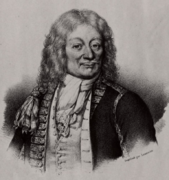Battle of Cartagena (1758) facts for kids
Quick facts for kids Battle of Cartagena |
|||||||
|---|---|---|---|---|---|---|---|
| Part of the Seven Years' War | |||||||
 Capture of the Foudroyant by HMS Monmouth, 28 February 1758, Francis Swaine |
|||||||
|
|||||||
| Belligerents | |||||||
| Commanders and leaders | |||||||
| Strength | |||||||
| 4 ships of the line | 3 ships of the line | ||||||
| Casualties and losses | |||||||
| Light | 2 ships of the line captured 1 ship of the line run aground |
||||||
The Battle of Cartagena was a naval fight that happened on February 28, 1758. It took place near the Spanish city of Cartagena in the Mediterranean Sea. This battle was part of the Seven Years' War, a big conflict between powerful European countries.
In this battle, a British fleet led by Admiral Henry Osborn fought against a French force. The French ships were trying to help another French fleet. The British had been blocking the French ships inside the port of Cartagena. Admiral Osborn's fleet won the battle.
This victory was very important. It stopped the French from sending many ships to Louisbourg in North America. Louisbourg was a French fortress that the British were trying to capture. Because of this battle, Louisbourg received only a little help and fell to the British later that year.
Contents
Why the Battle Happened
French Plans and British Blockade
In 1756, French ships had captured Minorca, an island in the Mediterranean. After this, the French navy stayed mostly in their port of Toulon. For about 18 months, they did not try to leave.
The British navy, based in Gibraltar, set up a strong blockade. This meant they guarded the entrance to the Mediterranean Sea. Their goal was to stop French ships from leaving or entering.
In 1757, the French wanted to send more ships to Louisbourg in North America. They hoped to stop the British from capturing it, just like they had done before. So, in November 1757, a French fleet of 15 ships sailed from Toulon. This fleet was led by Admiral La Clue.
Storm and Shelter
A big storm hit La Clue's fleet on November 30. The storm forced them to find shelter in the port of Cartagena. Cartagena was in Spain, which was a neutral country.
The British Admiral Henry Osborn quickly moved his ships to Cartagena. He trapped La Clue's fleet inside the port. Osborn's orders were clear: he had to prevent the French from escaping the Mediterranean Sea.
He soon learned that three more French warships were coming from Toulon. These ships were led by Michel de Menneville. Their plan was to join La Clue's fleet in Cartagena. Two other French ships had also managed to get into Cartagena earlier.
The Battle Begins
British Attack
Admiral Osborn was sailing near Cartagena when he saw Duquesne's ships approaching. Duquesne saw the larger British fleet. He knew his ships were outnumbered, so he ordered them to scatter.
Osborn made sure that La Clue's fleet was still trapped in Cartagena. This way, La Clue could not come out and help Duquesne. Then, Osborn sent some of his ships to chase the retreating French ships.
The Chase and Capture
One French ship, the Orphee, was caught by three British ships. It was quickly overpowered and captured. Another French ship, the Oriflamme, was deliberately run aground. This meant its crew intentionally steered it onto land to save it from being captured by the British.
The third French ship was the Foudroyant. This was Duquesne's own flagship, the ship he commanded from. The Foudroyant tried to escape the British chase. But the British ship Monmouth pursued it.
The chase lasted into the night. Finally, the Monmouth caught up with the French flagship. A fierce fight began between the two ships. During the battle, the Monmouth's captain, Arthur Gardiner, was killed. Despite this loss, the Monmouth kept fighting. In the end, the Foudroyant surrendered. Admiral Duquesne was taken prisoner. This marked the end of the battle.
What Happened Next
French Retreat and British Reputation
By July, Admiral Osborn decided it was too late in the year for the French to sail to North America. He pulled his ships away from Cartagena so they could get supplies. Admiral La Clue also realized he could not help Louisbourg. The fortress of Louisbourg fell to the British on July 26. La Clue and his ships then sailed back to Toulon. They did not try to force their way through the Straits of Gibraltar.
This battle greatly helped the reputation of the Royal Navy. The Royal Navy's image had been damaged after the Fall of Minorca in 1756. In that event, Admiral John Byng faced serious consequences for not doing his best to save Minorca.
Captain Arthur Gardiner, who died fighting in this battle, had been on Byng's flagship during the Battle of Minorca. His brave death helped to clear any doubts about his courage.
The Battle of Cartagena also showed a new way of fighting. The British used "tight blockade" tactics. This meant they kept a very close watch on enemy ports. They could do this better now because of new ways to supply ships at sea. This allowed their ships to stay on blockade for longer periods. The British would use these tactics even more effectively in the years to come.
See also
 In Spanish: Batalla de Cartagena (1758) para niños
In Spanish: Batalla de Cartagena (1758) para niños



